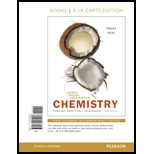
GENERAL ORGANIC+BIO...(LL)-W/MOD.ACCESS
3rd Edition
ISBN: 9780134466699
Author: FROST
Publisher: PEARSON
expand_more
expand_more
format_list_bulleted
Concept explainers
Question
Chapter 2, Problem 2.51AP
Summary Introduction
To determine:
The missing quantities in the given table.
Introduction:
The mass number of the element is the sum of number of protons and neutrons.
Expert Solution & Answer
Want to see the full answer?
Check out a sample textbook solution
Chapter 2 Solutions
GENERAL ORGANIC+BIO...(LL)-W/MOD.ACCESS
Ch. 2 - Where are the subatomic particles located in an...Ch. 2 - Prob. 2.2PPCh. 2 - Prob. 2.3PPCh. 2 - Prob. 2.4PPCh. 2 - How can you determine the following? a. the number...Ch. 2 - What can be determined from the following? a. the...Ch. 2 - Provide the name and atomic symbol of the element...Ch. 2 - Provide the name and atomic symbol of the element...Ch. 2 - Prob. 2.9PPCh. 2 - Prob. 2.10PP
Ch. 2 - Determine the number of protons, neutrons, and...Ch. 2 - Determine the number of protons, neutrons, and...Ch. 2 - Prob. 2.13PPCh. 2 - Prob. 2.14PPCh. 2 - Prob. 2.15PPCh. 2 - Prob. 2.16PPCh. 2 - Prob. 2.17PPCh. 2 - How are atomic mass and mass number similar? How...Ch. 2 - There are three naturally occurring isotopes of...Ch. 2 - Prob. 2.20PPCh. 2 - Prob. 2.21PPCh. 2 - Prob. 2.22PPCh. 2 - Prob. 2.23PPCh. 2 - Prob. 2.24PPCh. 2 - Prob. 2.25PPCh. 2 - Prob. 2.26PPCh. 2 - Prob. 2.27PPCh. 2 - Prob. 2.28PPCh. 2 - Prob. 2.29PPCh. 2 - Prob. 2.30PPCh. 2 - Prob. 2.31PPCh. 2 - Prob. 2.32PPCh. 2 - What does the unit sievert measure?Ch. 2 - Prob. 2.34PPCh. 2 - Prob. 2.35PPCh. 2 - Prob. 2.36PPCh. 2 - Prob. 2.37PPCh. 2 - Prob. 2.38PPCh. 2 - Prob. 2.39PPCh. 2 - Prob. 2.40PPCh. 2 - Prob. 2.41PPCh. 2 - Prob. 2.42PPCh. 2 - Prob. 2.43PPCh. 2 - Prob. 2.44PPCh. 2 - Complete the following statements: a. A...Ch. 2 - Complete the following statements: a. The mass...Ch. 2 - Prob. 2.47APCh. 2 - Prob. 2.48APCh. 2 - Prob. 2.49APCh. 2 - Prob. 2.50APCh. 2 - Prob. 2.51APCh. 2 - Prob. 2.52APCh. 2 - Prob. 2.53APCh. 2 - Prob. 2.54APCh. 2 - Prob. 2.55APCh. 2 - Prob. 2.56APCh. 2 - Prob. 2.57APCh. 2 - Prob. 2.58APCh. 2 - Prob. 2.59APCh. 2 - Prob. 2.60APCh. 2 - Prob. 2.61APCh. 2 - Prob. 2.62APCh. 2 - Prob. 2.63APCh. 2 - Prob. 2.64APCh. 2 - Prob. 2.65APCh. 2 - Prob. 2.66APCh. 2 - Prob. 2.67APCh. 2 - Prob. 2.68APCh. 2 - A 25-mL sample of chromium-51 contains 1.00 mCi....Ch. 2 - Prob. 2.70APCh. 2 - Prob. 2.71APCh. 2 - Prob. 2.72APCh. 2 - Prob. 2.73APCh. 2 - Prob. 2.74APCh. 2 - Prob. 2.75APCh. 2 - Prob. 2.76APCh. 2 - Prob. 2.77CPCh. 2 - Prob. 2.78CPCh. 2 - PET scans are useful for imaging areas of high...Ch. 2 - Prob. 1IA.1QCh. 2 - Prob. 1IA.2QCh. 2 - Prob. 1IA.3QCh. 2 - Prob. 1IA.4QCh. 2 - Prob. 1IA.5QCh. 2 - Prob. 1IA.6QCh. 2 - Prob. 1IA.7QCh. 2 - Prob. 1IA.8QCh. 2 - Prob. 1IA.9QCh. 2 - Prob. 1IA.10QCh. 2 - Prob. 1IA.11QCh. 2 - Prob. 2IA.1QCh. 2 - Prob. 2IA.2QCh. 2 - Prob. 2IA.3QCh. 2 - Prob. 2IA.4QCh. 2 - Prob. 1ICCh. 2 - Prob. 2IC
Knowledge Booster
Learn more about
Need a deep-dive on the concept behind this application? Look no further. Learn more about this topic, chemistry and related others by exploring similar questions and additional content below.Atomic Number, Atomic Mass, and the Atomic Structure | How to Pass ChemistryThe Nucleus: Crash Course Chemistry #1; Author: Crash Course;https://www.youtube.com/watch?v=FSyAehMdpyI;License: Standard YouTube License, CC-BY